Agronomy Crop Sequence Plan and Management for Temperate Crops
VerifiedAdded on 2022/12/23
|17
|4021
|54
Report
AI Summary
This report presents a detailed crop sequence plan for a temperate climate, focusing on the cultivation of wheat, barley, poppies, dual-purpose canola, and forage rape. The plan emphasizes the importance of crop rotation to manage diseases and pests effectively, with specific considerations for weed control through herbicides and paddock preparation for optimal drainage. The report outlines the agronomic management practices for each crop, including fertilizer applications, sowing times, harvesting methods, and justifications for the sequence based on factors like nutrient replenishment and disease control. The analysis includes yield characteristics, forage quality, and specific considerations for each crop's requirements, such as boron for poppies and the use of barley for soil erosion control. The document provides a comprehensive overview of the crop sequence, agronomic planning, and management strategies for successful and sustainable farming in a temperate environment.
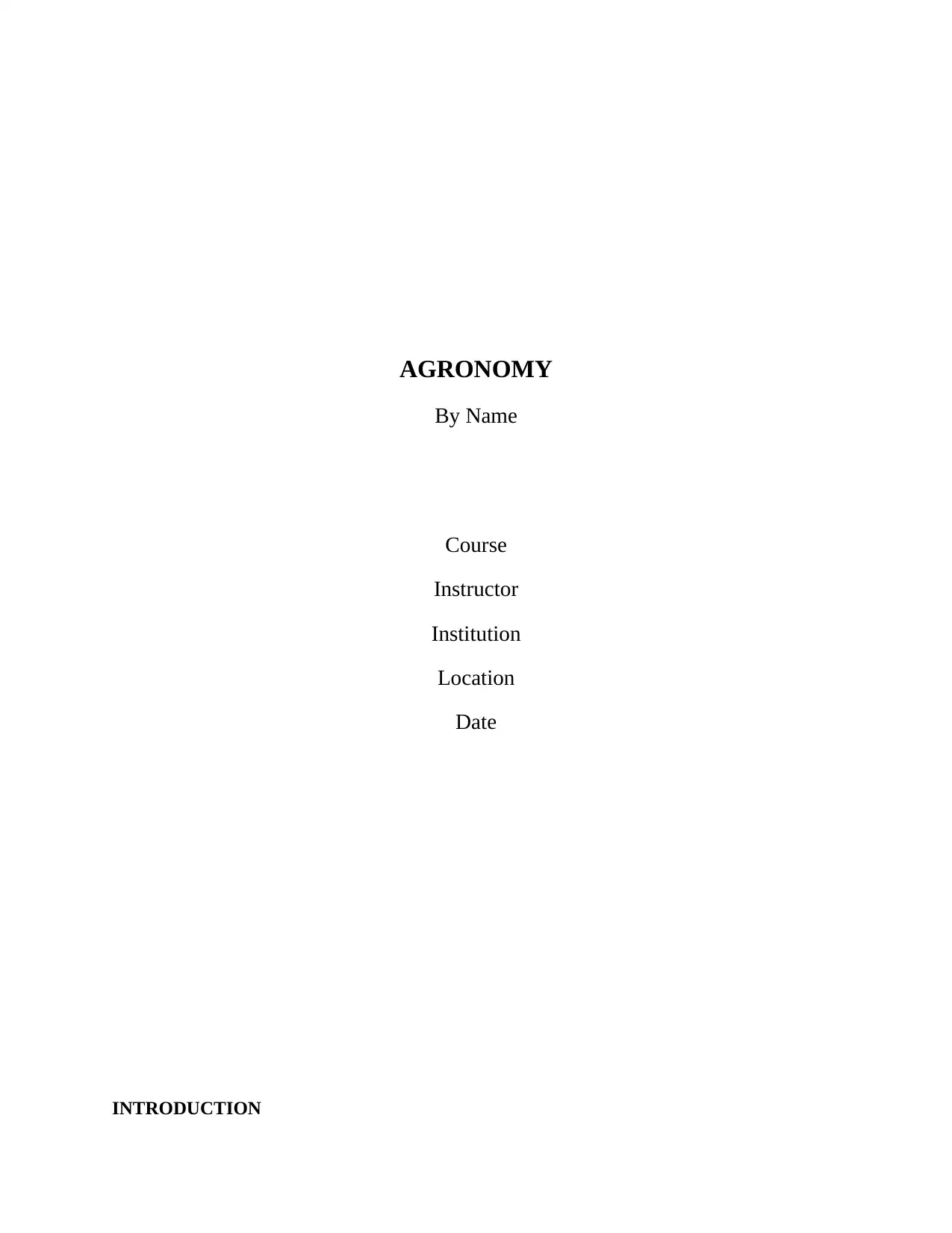
AGRONOMY
By Name
Course
Instructor
Institution
Location
Date
INTRODUCTION
By Name
Course
Instructor
Institution
Location
Date
INTRODUCTION
Paraphrase This Document
Need a fresh take? Get an instant paraphrase of this document with our AI Paraphraser
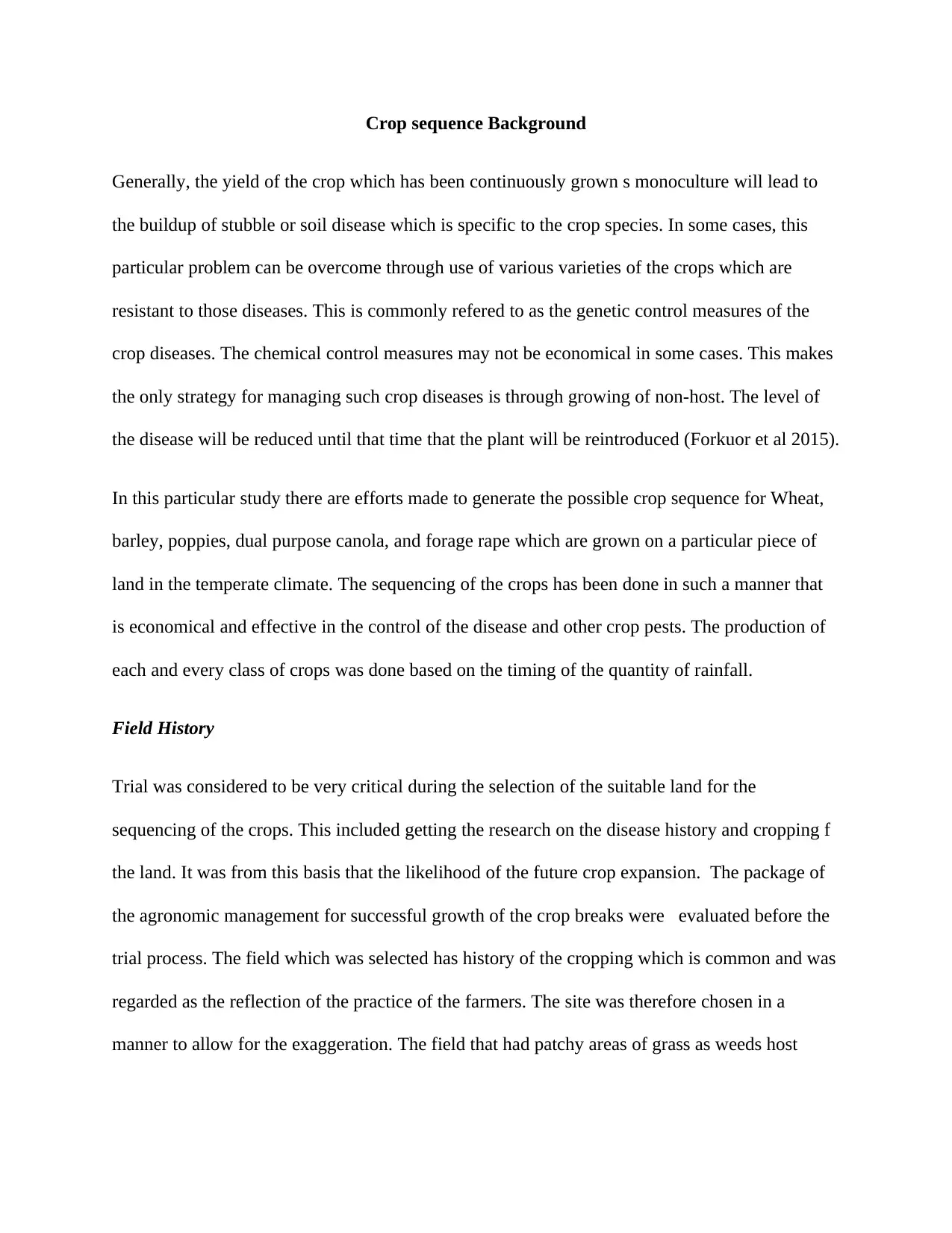
Crop sequence Background
Generally, the yield of the crop which has been continuously grown s monoculture will lead to
the buildup of stubble or soil disease which is specific to the crop species. In some cases, this
particular problem can be overcome through use of various varieties of the crops which are
resistant to those diseases. This is commonly refered to as the genetic control measures of the
crop diseases. The chemical control measures may not be economical in some cases. This makes
the only strategy for managing such crop diseases is through growing of non-host. The level of
the disease will be reduced until that time that the plant will be reintroduced (Forkuor et al 2015).
In this particular study there are efforts made to generate the possible crop sequence for Wheat,
barley, poppies, dual purpose canola, and forage rape which are grown on a particular piece of
land in the temperate climate. The sequencing of the crops has been done in such a manner that
is economical and effective in the control of the disease and other crop pests. The production of
each and every class of crops was done based on the timing of the quantity of rainfall.
Field History
Trial was considered to be very critical during the selection of the suitable land for the
sequencing of the crops. This included getting the research on the disease history and cropping f
the land. It was from this basis that the likelihood of the future crop expansion. The package of
the agronomic management for successful growth of the crop breaks were evaluated before the
trial process. The field which was selected has history of the cropping which is common and was
regarded as the reflection of the practice of the farmers. The site was therefore chosen in a
manner to allow for the exaggeration. The field that had patchy areas of grass as weeds host
Generally, the yield of the crop which has been continuously grown s monoculture will lead to
the buildup of stubble or soil disease which is specific to the crop species. In some cases, this
particular problem can be overcome through use of various varieties of the crops which are
resistant to those diseases. This is commonly refered to as the genetic control measures of the
crop diseases. The chemical control measures may not be economical in some cases. This makes
the only strategy for managing such crop diseases is through growing of non-host. The level of
the disease will be reduced until that time that the plant will be reintroduced (Forkuor et al 2015).
In this particular study there are efforts made to generate the possible crop sequence for Wheat,
barley, poppies, dual purpose canola, and forage rape which are grown on a particular piece of
land in the temperate climate. The sequencing of the crops has been done in such a manner that
is economical and effective in the control of the disease and other crop pests. The production of
each and every class of crops was done based on the timing of the quantity of rainfall.
Field History
Trial was considered to be very critical during the selection of the suitable land for the
sequencing of the crops. This included getting the research on the disease history and cropping f
the land. It was from this basis that the likelihood of the future crop expansion. The package of
the agronomic management for successful growth of the crop breaks were evaluated before the
trial process. The field which was selected has history of the cropping which is common and was
regarded as the reflection of the practice of the farmers. The site was therefore chosen in a
manner to allow for the exaggeration. The field that had patchy areas of grass as weeds host
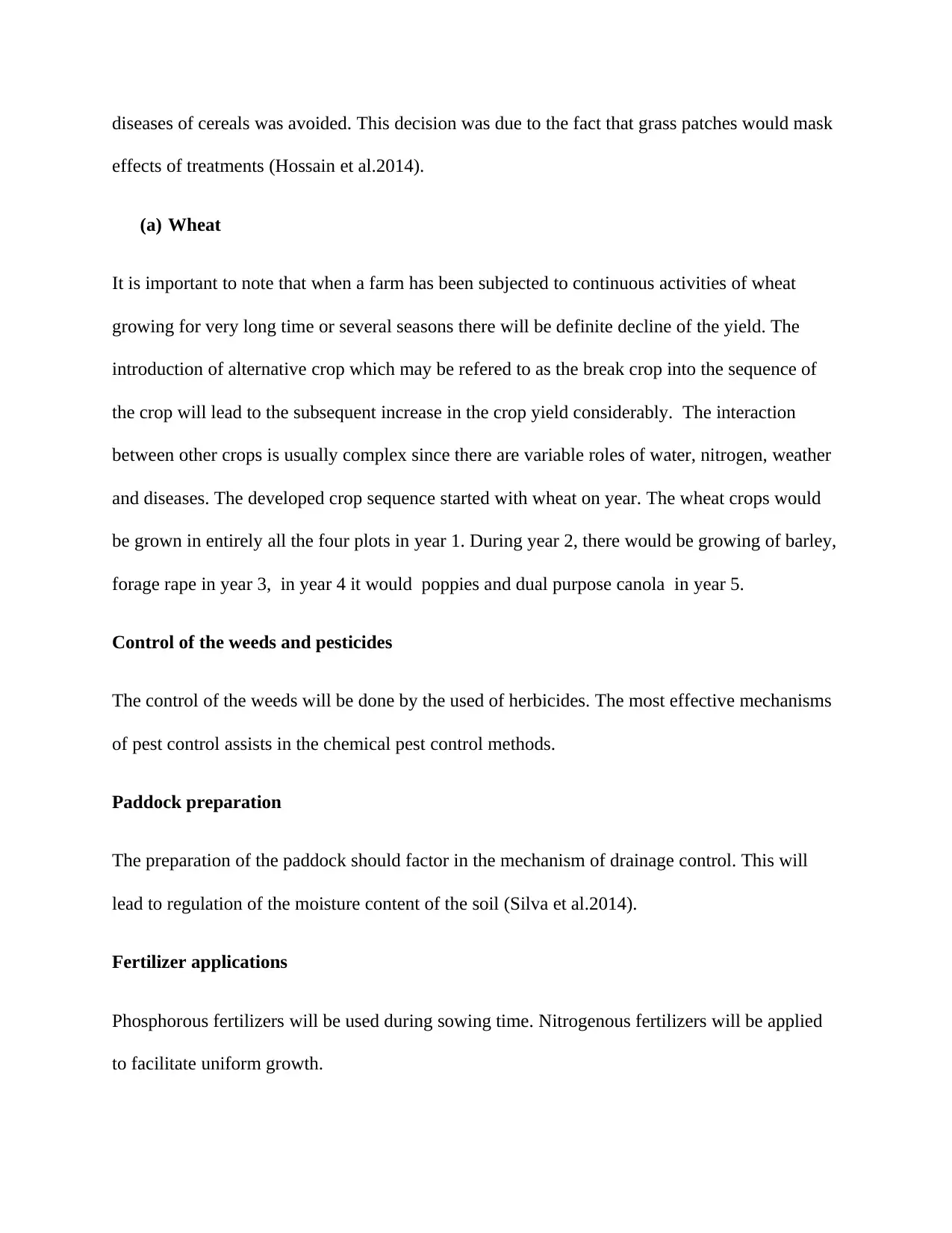
diseases of cereals was avoided. This decision was due to the fact that grass patches would mask
effects of treatments (Hossain et al.2014).
(a) Wheat
It is important to note that when a farm has been subjected to continuous activities of wheat
growing for very long time or several seasons there will be definite decline of the yield. The
introduction of alternative crop which may be refered to as the break crop into the sequence of
the crop will lead to the subsequent increase in the crop yield considerably. The interaction
between other crops is usually complex since there are variable roles of water, nitrogen, weather
and diseases. The developed crop sequence started with wheat on year. The wheat crops would
be grown in entirely all the four plots in year 1. During year 2, there would be growing of barley,
forage rape in year 3, in year 4 it would poppies and dual purpose canola in year 5.
Control of the weeds and pesticides
The control of the weeds will be done by the used of herbicides. The most effective mechanisms
of pest control assists in the chemical pest control methods.
Paddock preparation
The preparation of the paddock should factor in the mechanism of drainage control. This will
lead to regulation of the moisture content of the soil (Silva et al.2014).
Fertilizer applications
Phosphorous fertilizers will be used during sowing time. Nitrogenous fertilizers will be applied
to facilitate uniform growth.
effects of treatments (Hossain et al.2014).
(a) Wheat
It is important to note that when a farm has been subjected to continuous activities of wheat
growing for very long time or several seasons there will be definite decline of the yield. The
introduction of alternative crop which may be refered to as the break crop into the sequence of
the crop will lead to the subsequent increase in the crop yield considerably. The interaction
between other crops is usually complex since there are variable roles of water, nitrogen, weather
and diseases. The developed crop sequence started with wheat on year. The wheat crops would
be grown in entirely all the four plots in year 1. During year 2, there would be growing of barley,
forage rape in year 3, in year 4 it would poppies and dual purpose canola in year 5.
Control of the weeds and pesticides
The control of the weeds will be done by the used of herbicides. The most effective mechanisms
of pest control assists in the chemical pest control methods.
Paddock preparation
The preparation of the paddock should factor in the mechanism of drainage control. This will
lead to regulation of the moisture content of the soil (Silva et al.2014).
Fertilizer applications
Phosphorous fertilizers will be used during sowing time. Nitrogenous fertilizers will be applied
to facilitate uniform growth.
⊘ This is a preview!⊘
Do you want full access?
Subscribe today to unlock all pages.

Trusted by 1+ million students worldwide
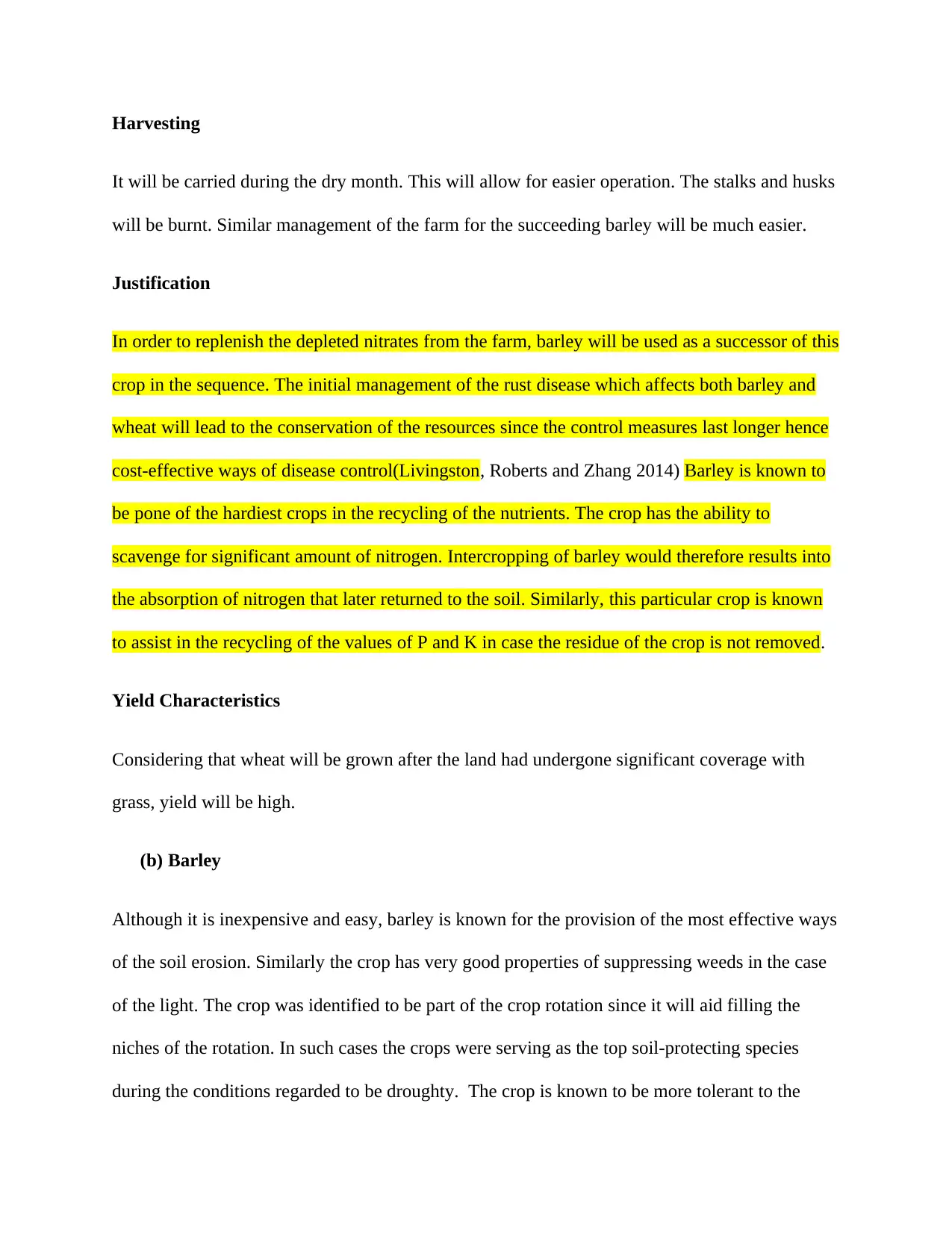
Harvesting
It will be carried during the dry month. This will allow for easier operation. The stalks and husks
will be burnt. Similar management of the farm for the succeeding barley will be much easier.
Justification
In order to replenish the depleted nitrates from the farm, barley will be used as a successor of this
crop in the sequence. The initial management of the rust disease which affects both barley and
wheat will lead to the conservation of the resources since the control measures last longer hence
cost-effective ways of disease control(Livingston, Roberts and Zhang 2014) Barley is known to
be pone of the hardiest crops in the recycling of the nutrients. The crop has the ability to
scavenge for significant amount of nitrogen. Intercropping of barley would therefore results into
the absorption of nitrogen that later returned to the soil. Similarly, this particular crop is known
to assist in the recycling of the values of P and K in case the residue of the crop is not removed.
Yield Characteristics
Considering that wheat will be grown after the land had undergone significant coverage with
grass, yield will be high.
(b) Barley
Although it is inexpensive and easy, barley is known for the provision of the most effective ways
of the soil erosion. Similarly the crop has very good properties of suppressing weeds in the case
of the light. The crop was identified to be part of the crop rotation since it will aid filling the
niches of the rotation. In such cases the crops were serving as the top soil-protecting species
during the conditions regarded to be droughty. The crop is known to be more tolerant to the
It will be carried during the dry month. This will allow for easier operation. The stalks and husks
will be burnt. Similar management of the farm for the succeeding barley will be much easier.
Justification
In order to replenish the depleted nitrates from the farm, barley will be used as a successor of this
crop in the sequence. The initial management of the rust disease which affects both barley and
wheat will lead to the conservation of the resources since the control measures last longer hence
cost-effective ways of disease control(Livingston, Roberts and Zhang 2014) Barley is known to
be pone of the hardiest crops in the recycling of the nutrients. The crop has the ability to
scavenge for significant amount of nitrogen. Intercropping of barley would therefore results into
the absorption of nitrogen that later returned to the soil. Similarly, this particular crop is known
to assist in the recycling of the values of P and K in case the residue of the crop is not removed.
Yield Characteristics
Considering that wheat will be grown after the land had undergone significant coverage with
grass, yield will be high.
(b) Barley
Although it is inexpensive and easy, barley is known for the provision of the most effective ways
of the soil erosion. Similarly the crop has very good properties of suppressing weeds in the case
of the light. The crop was identified to be part of the crop rotation since it will aid filling the
niches of the rotation. In such cases the crops were serving as the top soil-protecting species
during the conditions regarded to be droughty. The crop is known to be more tolerant to the
Paraphrase This Document
Need a fresh take? Get an instant paraphrase of this document with our AI Paraphraser
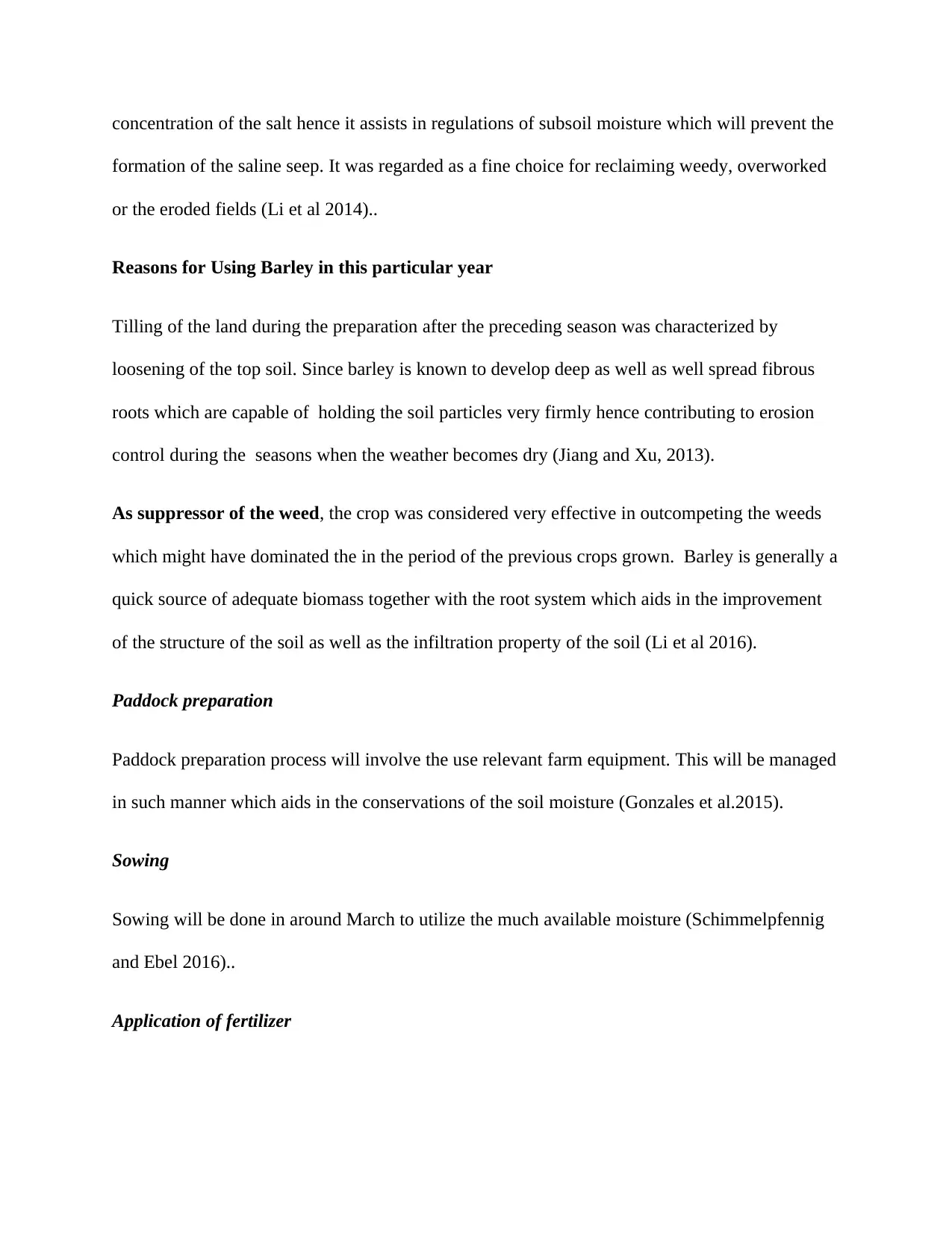
concentration of the salt hence it assists in regulations of subsoil moisture which will prevent the
formation of the saline seep. It was regarded as a fine choice for reclaiming weedy, overworked
or the eroded fields (Li et al 2014)..
Reasons for Using Barley in this particular year
Tilling of the land during the preparation after the preceding season was characterized by
loosening of the top soil. Since barley is known to develop deep as well as well spread fibrous
roots which are capable of holding the soil particles very firmly hence contributing to erosion
control during the seasons when the weather becomes dry (Jiang and Xu, 2013).
As suppressor of the weed, the crop was considered very effective in outcompeting the weeds
which might have dominated the in the period of the previous crops grown. Barley is generally a
quick source of adequate biomass together with the root system which aids in the improvement
of the structure of the soil as well as the infiltration property of the soil (Li et al 2016).
Paddock preparation
Paddock preparation process will involve the use relevant farm equipment. This will be managed
in such manner which aids in the conservations of the soil moisture (Gonzales et al.2015).
Sowing
Sowing will be done in around March to utilize the much available moisture (Schimmelpfennig
and Ebel 2016)..
Application of fertilizer
formation of the saline seep. It was regarded as a fine choice for reclaiming weedy, overworked
or the eroded fields (Li et al 2014)..
Reasons for Using Barley in this particular year
Tilling of the land during the preparation after the preceding season was characterized by
loosening of the top soil. Since barley is known to develop deep as well as well spread fibrous
roots which are capable of holding the soil particles very firmly hence contributing to erosion
control during the seasons when the weather becomes dry (Jiang and Xu, 2013).
As suppressor of the weed, the crop was considered very effective in outcompeting the weeds
which might have dominated the in the period of the previous crops grown. Barley is generally a
quick source of adequate biomass together with the root system which aids in the improvement
of the structure of the soil as well as the infiltration property of the soil (Li et al 2016).
Paddock preparation
Paddock preparation process will involve the use relevant farm equipment. This will be managed
in such manner which aids in the conservations of the soil moisture (Gonzales et al.2015).
Sowing
Sowing will be done in around March to utilize the much available moisture (Schimmelpfennig
and Ebel 2016)..
Application of fertilizer
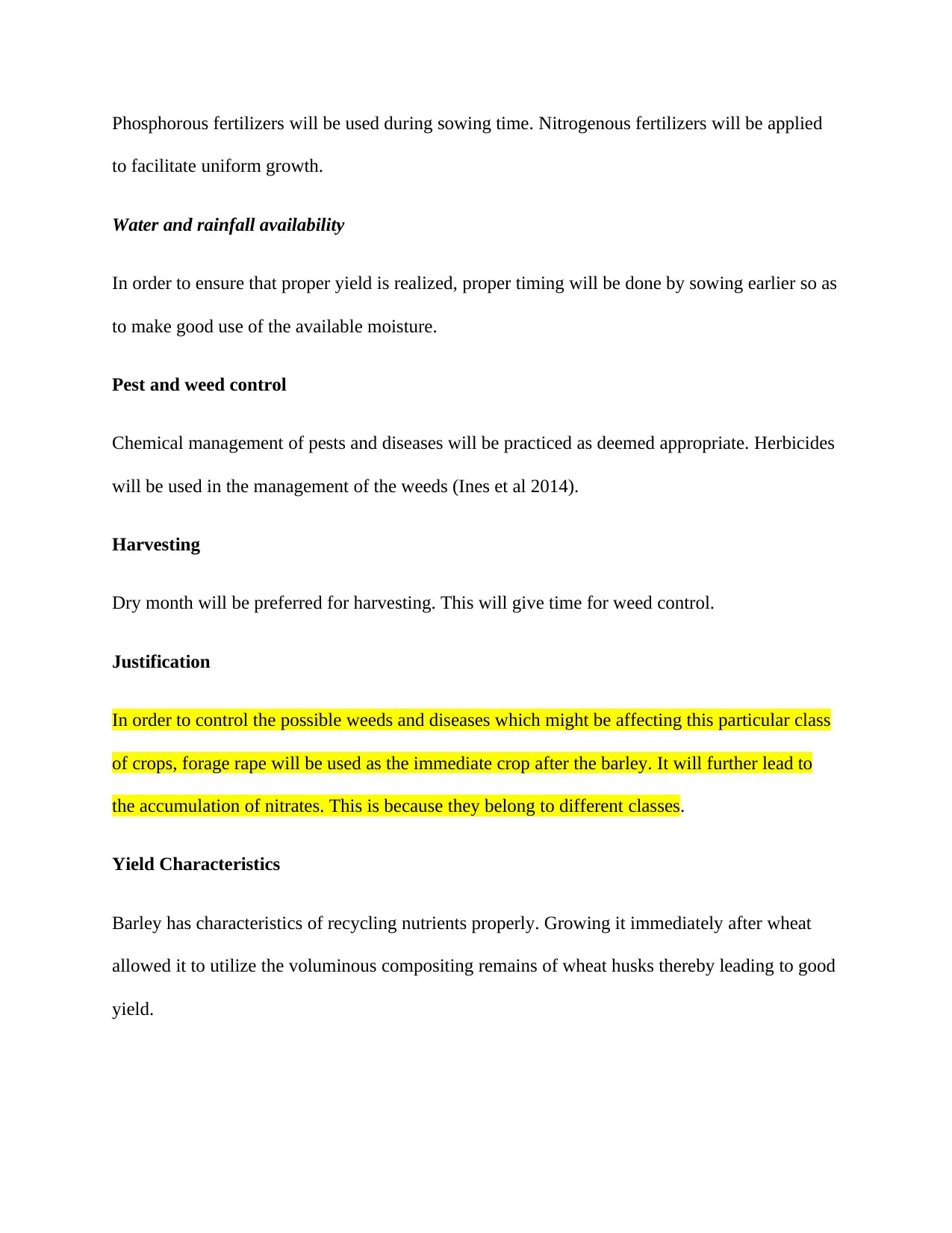
Phosphorous fertilizers will be used during sowing time. Nitrogenous fertilizers will be applied
to facilitate uniform growth.
Water and rainfall availability
In order to ensure that proper yield is realized, proper timing will be done by sowing earlier so as
to make good use of the available moisture.
Pest and weed control
Chemical management of pests and diseases will be practiced as deemed appropriate. Herbicides
will be used in the management of the weeds (Ines et al 2014).
Harvesting
Dry month will be preferred for harvesting. This will give time for weed control.
Justification
In order to control the possible weeds and diseases which might be affecting this particular class
of crops, forage rape will be used as the immediate crop after the barley. It will further lead to
the accumulation of nitrates. This is because they belong to different classes.
Yield Characteristics
Barley has characteristics of recycling nutrients properly. Growing it immediately after wheat
allowed it to utilize the voluminous compositing remains of wheat husks thereby leading to good
yield.
to facilitate uniform growth.
Water and rainfall availability
In order to ensure that proper yield is realized, proper timing will be done by sowing earlier so as
to make good use of the available moisture.
Pest and weed control
Chemical management of pests and diseases will be practiced as deemed appropriate. Herbicides
will be used in the management of the weeds (Ines et al 2014).
Harvesting
Dry month will be preferred for harvesting. This will give time for weed control.
Justification
In order to control the possible weeds and diseases which might be affecting this particular class
of crops, forage rape will be used as the immediate crop after the barley. It will further lead to
the accumulation of nitrates. This is because they belong to different classes.
Yield Characteristics
Barley has characteristics of recycling nutrients properly. Growing it immediately after wheat
allowed it to utilize the voluminous compositing remains of wheat husks thereby leading to good
yield.
⊘ This is a preview!⊘
Do you want full access?
Subscribe today to unlock all pages.

Trusted by 1+ million students worldwide
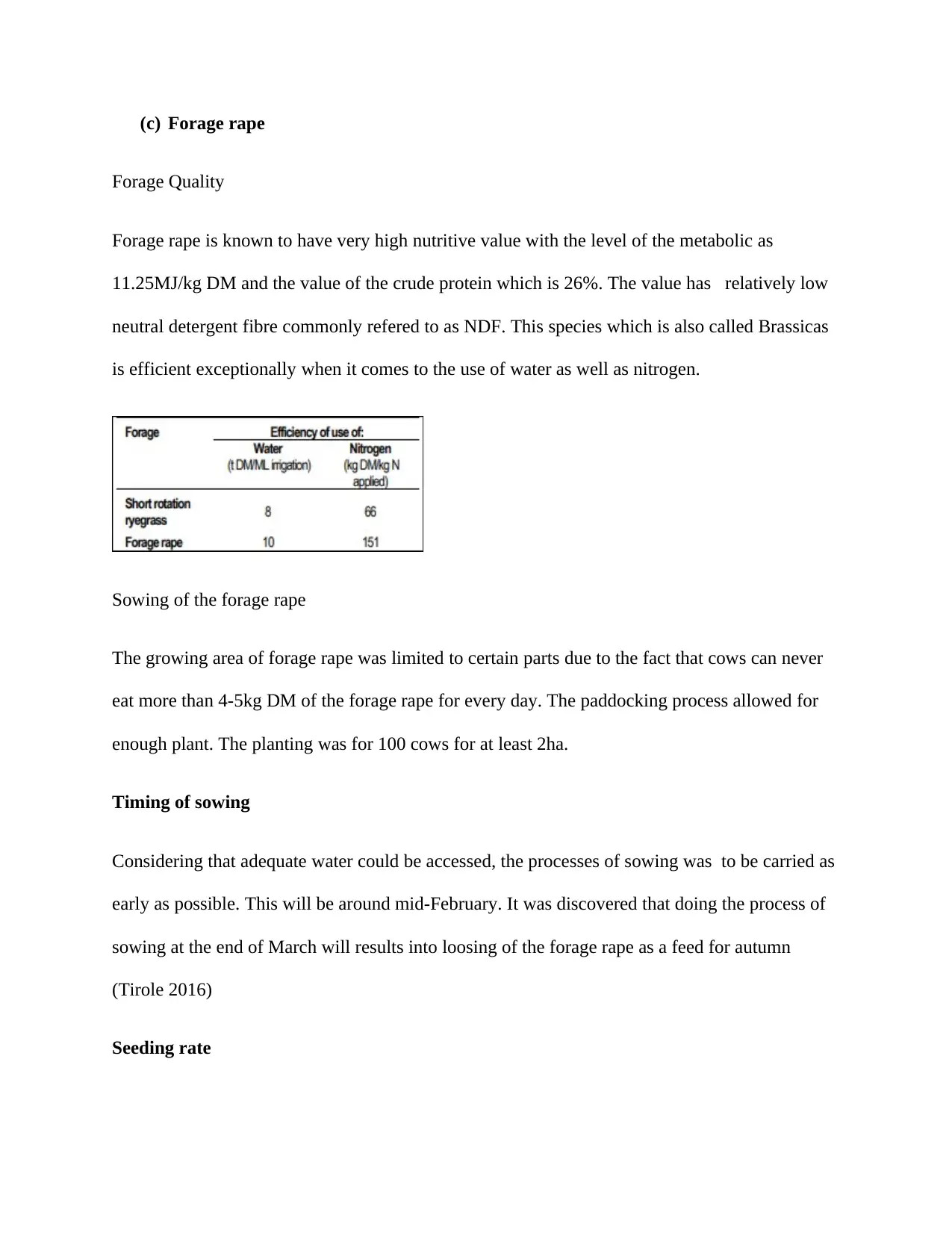
(c) Forage rape
Forage Quality
Forage rape is known to have very high nutritive value with the level of the metabolic as
11.25MJ/kg DM and the value of the crude protein which is 26%. The value has relatively low
neutral detergent fibre commonly refered to as NDF. This species which is also called Brassicas
is efficient exceptionally when it comes to the use of water as well as nitrogen.
Sowing of the forage rape
The growing area of forage rape was limited to certain parts due to the fact that cows can never
eat more than 4-5kg DM of the forage rape for every day. The paddocking process allowed for
enough plant. The planting was for 100 cows for at least 2ha.
Timing of sowing
Considering that adequate water could be accessed, the processes of sowing was to be carried as
early as possible. This will be around mid-February. It was discovered that doing the process of
sowing at the end of March will results into loosing of the forage rape as a feed for autumn
(Tirole 2016)
Seeding rate
Forage Quality
Forage rape is known to have very high nutritive value with the level of the metabolic as
11.25MJ/kg DM and the value of the crude protein which is 26%. The value has relatively low
neutral detergent fibre commonly refered to as NDF. This species which is also called Brassicas
is efficient exceptionally when it comes to the use of water as well as nitrogen.
Sowing of the forage rape
The growing area of forage rape was limited to certain parts due to the fact that cows can never
eat more than 4-5kg DM of the forage rape for every day. The paddocking process allowed for
enough plant. The planting was for 100 cows for at least 2ha.
Timing of sowing
Considering that adequate water could be accessed, the processes of sowing was to be carried as
early as possible. This will be around mid-February. It was discovered that doing the process of
sowing at the end of March will results into loosing of the forage rape as a feed for autumn
(Tirole 2016)
Seeding rate
Paraphrase This Document
Need a fresh take? Get an instant paraphrase of this document with our AI Paraphraser
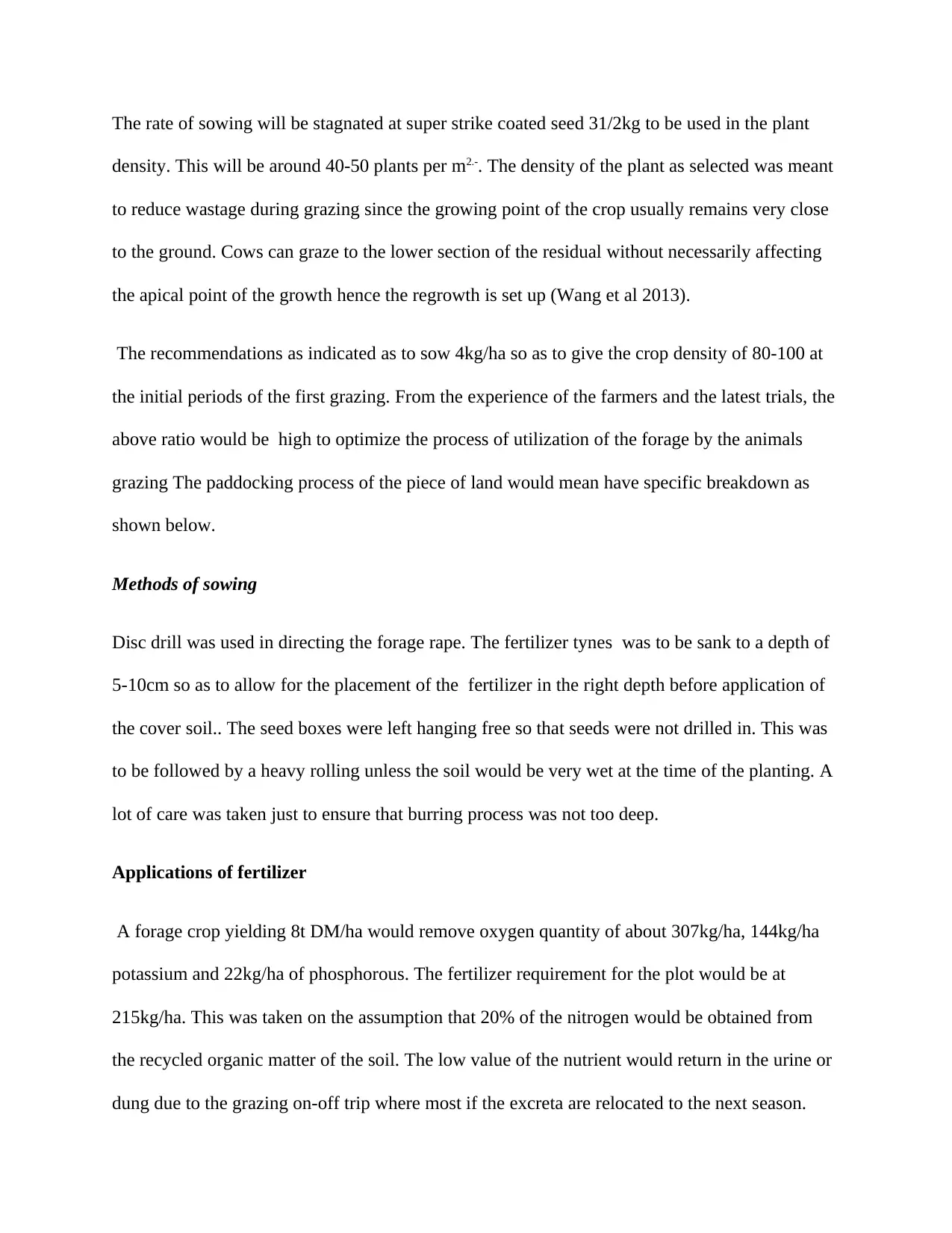
The rate of sowing will be stagnated at super strike coated seed 31/2kg to be used in the plant
density. This will be around 40-50 plants per m2.-. The density of the plant as selected was meant
to reduce wastage during grazing since the growing point of the crop usually remains very close
to the ground. Cows can graze to the lower section of the residual without necessarily affecting
the apical point of the growth hence the regrowth is set up (Wang et al 2013).
The recommendations as indicated as to sow 4kg/ha so as to give the crop density of 80-100 at
the initial periods of the first grazing. From the experience of the farmers and the latest trials, the
above ratio would be high to optimize the process of utilization of the forage by the animals
grazing The paddocking process of the piece of land would mean have specific breakdown as
shown below.
Methods of sowing
Disc drill was used in directing the forage rape. The fertilizer tynes was to be sank to a depth of
5-10cm so as to allow for the placement of the fertilizer in the right depth before application of
the cover soil.. The seed boxes were left hanging free so that seeds were not drilled in. This was
to be followed by a heavy rolling unless the soil would be very wet at the time of the planting. A
lot of care was taken just to ensure that burring process was not too deep.
Applications of fertilizer
A forage crop yielding 8t DM/ha would remove oxygen quantity of about 307kg/ha, 144kg/ha
potassium and 22kg/ha of phosphorous. The fertilizer requirement for the plot would be at
215kg/ha. This was taken on the assumption that 20% of the nitrogen would be obtained from
the recycled organic matter of the soil. The low value of the nutrient would return in the urine or
dung due to the grazing on-off trip where most if the excreta are relocated to the next season.
density. This will be around 40-50 plants per m2.-. The density of the plant as selected was meant
to reduce wastage during grazing since the growing point of the crop usually remains very close
to the ground. Cows can graze to the lower section of the residual without necessarily affecting
the apical point of the growth hence the regrowth is set up (Wang et al 2013).
The recommendations as indicated as to sow 4kg/ha so as to give the crop density of 80-100 at
the initial periods of the first grazing. From the experience of the farmers and the latest trials, the
above ratio would be high to optimize the process of utilization of the forage by the animals
grazing The paddocking process of the piece of land would mean have specific breakdown as
shown below.
Methods of sowing
Disc drill was used in directing the forage rape. The fertilizer tynes was to be sank to a depth of
5-10cm so as to allow for the placement of the fertilizer in the right depth before application of
the cover soil.. The seed boxes were left hanging free so that seeds were not drilled in. This was
to be followed by a heavy rolling unless the soil would be very wet at the time of the planting. A
lot of care was taken just to ensure that burring process was not too deep.
Applications of fertilizer
A forage crop yielding 8t DM/ha would remove oxygen quantity of about 307kg/ha, 144kg/ha
potassium and 22kg/ha of phosphorous. The fertilizer requirement for the plot would be at
215kg/ha. This was taken on the assumption that 20% of the nitrogen would be obtained from
the recycled organic matter of the soil. The low value of the nutrient would return in the urine or
dung due to the grazing on-off trip where most if the excreta are relocated to the next season.
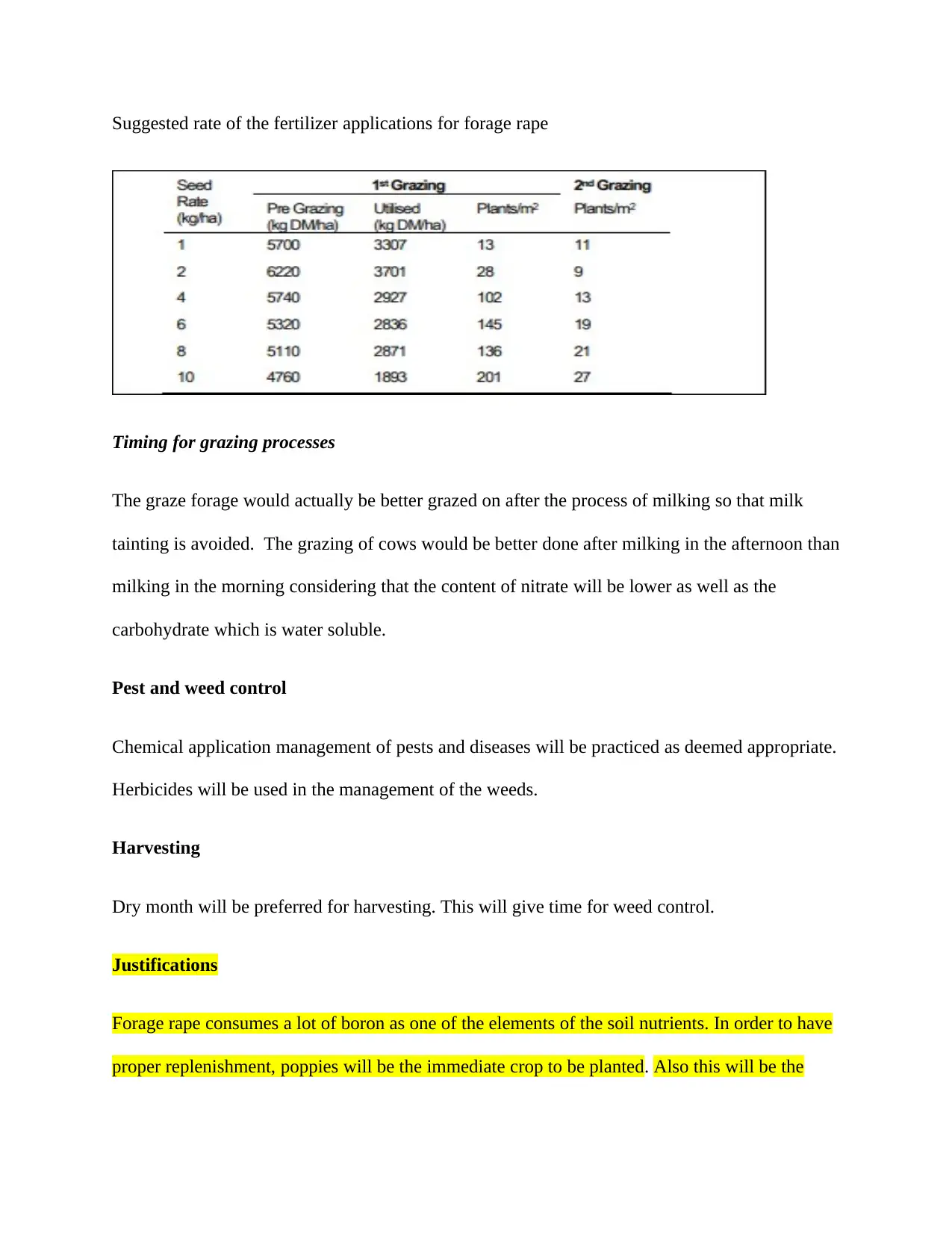
Suggested rate of the fertilizer applications for forage rape
Timing for grazing processes
The graze forage would actually be better grazed on after the process of milking so that milk
tainting is avoided. The grazing of cows would be better done after milking in the afternoon than
milking in the morning considering that the content of nitrate will be lower as well as the
carbohydrate which is water soluble.
Pest and weed control
Chemical application management of pests and diseases will be practiced as deemed appropriate.
Herbicides will be used in the management of the weeds.
Harvesting
Dry month will be preferred for harvesting. This will give time for weed control.
Justifications
Forage rape consumes a lot of boron as one of the elements of the soil nutrients. In order to have
proper replenishment, poppies will be the immediate crop to be planted. Also this will be the
Timing for grazing processes
The graze forage would actually be better grazed on after the process of milking so that milk
tainting is avoided. The grazing of cows would be better done after milking in the afternoon than
milking in the morning considering that the content of nitrate will be lower as well as the
carbohydrate which is water soluble.
Pest and weed control
Chemical application management of pests and diseases will be practiced as deemed appropriate.
Herbicides will be used in the management of the weeds.
Harvesting
Dry month will be preferred for harvesting. This will give time for weed control.
Justifications
Forage rape consumes a lot of boron as one of the elements of the soil nutrients. In order to have
proper replenishment, poppies will be the immediate crop to be planted. Also this will be the
⊘ This is a preview!⊘
Do you want full access?
Subscribe today to unlock all pages.

Trusted by 1+ million students worldwide
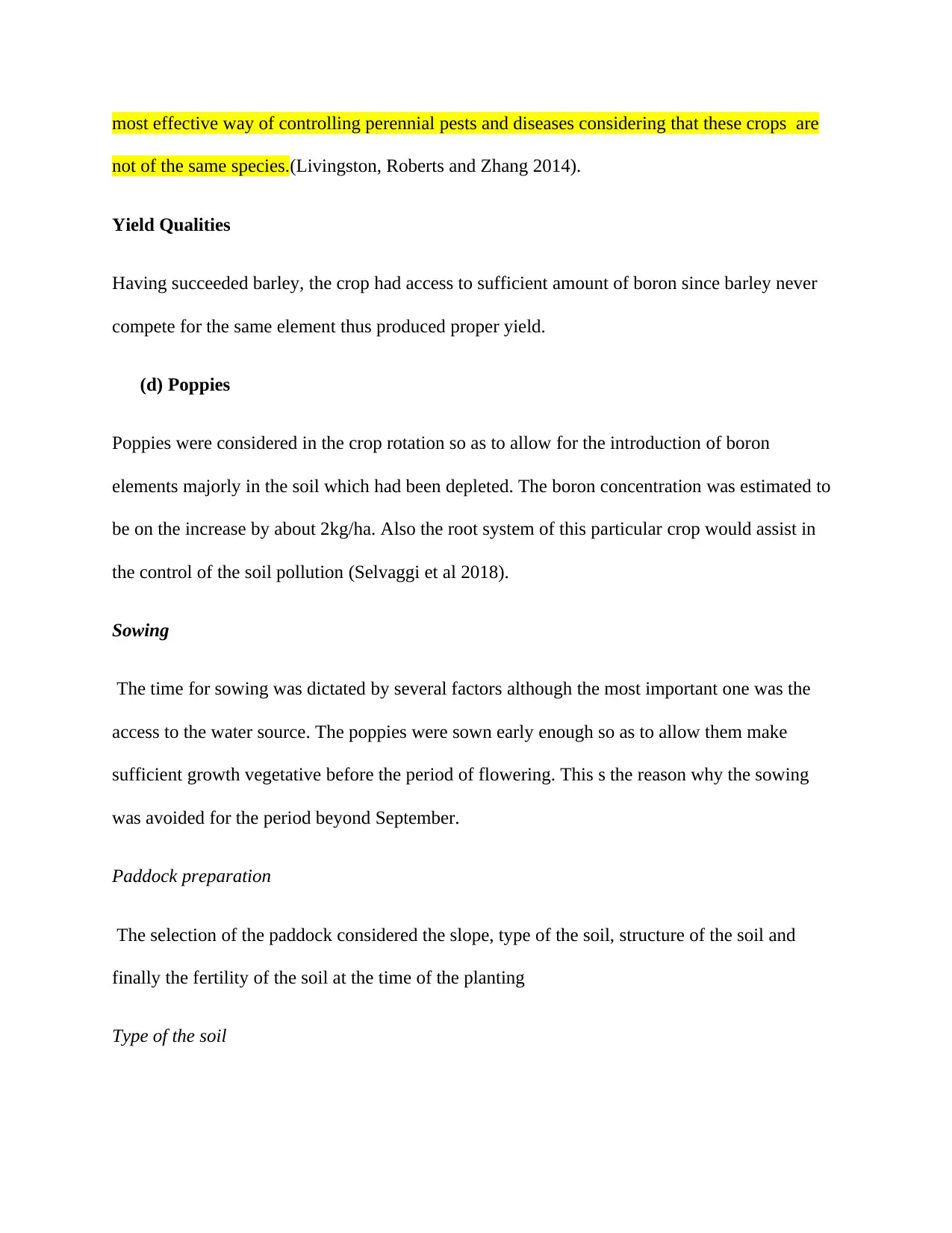
most effective way of controlling perennial pests and diseases considering that these crops are
not of the same species.(Livingston, Roberts and Zhang 2014).
Yield Qualities
Having succeeded barley, the crop had access to sufficient amount of boron since barley never
compete for the same element thus produced proper yield.
(d) Poppies
Poppies were considered in the crop rotation so as to allow for the introduction of boron
elements majorly in the soil which had been depleted. The boron concentration was estimated to
be on the increase by about 2kg/ha. Also the root system of this particular crop would assist in
the control of the soil pollution (Selvaggi et al 2018).
Sowing
The time for sowing was dictated by several factors although the most important one was the
access to the water source. The poppies were sown early enough so as to allow them make
sufficient growth vegetative before the period of flowering. This s the reason why the sowing
was avoided for the period beyond September.
Paddock preparation
The selection of the paddock considered the slope, type of the soil, structure of the soil and
finally the fertility of the soil at the time of the planting
Type of the soil
not of the same species.(Livingston, Roberts and Zhang 2014).
Yield Qualities
Having succeeded barley, the crop had access to sufficient amount of boron since barley never
compete for the same element thus produced proper yield.
(d) Poppies
Poppies were considered in the crop rotation so as to allow for the introduction of boron
elements majorly in the soil which had been depleted. The boron concentration was estimated to
be on the increase by about 2kg/ha. Also the root system of this particular crop would assist in
the control of the soil pollution (Selvaggi et al 2018).
Sowing
The time for sowing was dictated by several factors although the most important one was the
access to the water source. The poppies were sown early enough so as to allow them make
sufficient growth vegetative before the period of flowering. This s the reason why the sowing
was avoided for the period beyond September.
Paddock preparation
The selection of the paddock considered the slope, type of the soil, structure of the soil and
finally the fertility of the soil at the time of the planting
Type of the soil
Paraphrase This Document
Need a fresh take? Get an instant paraphrase of this document with our AI Paraphraser
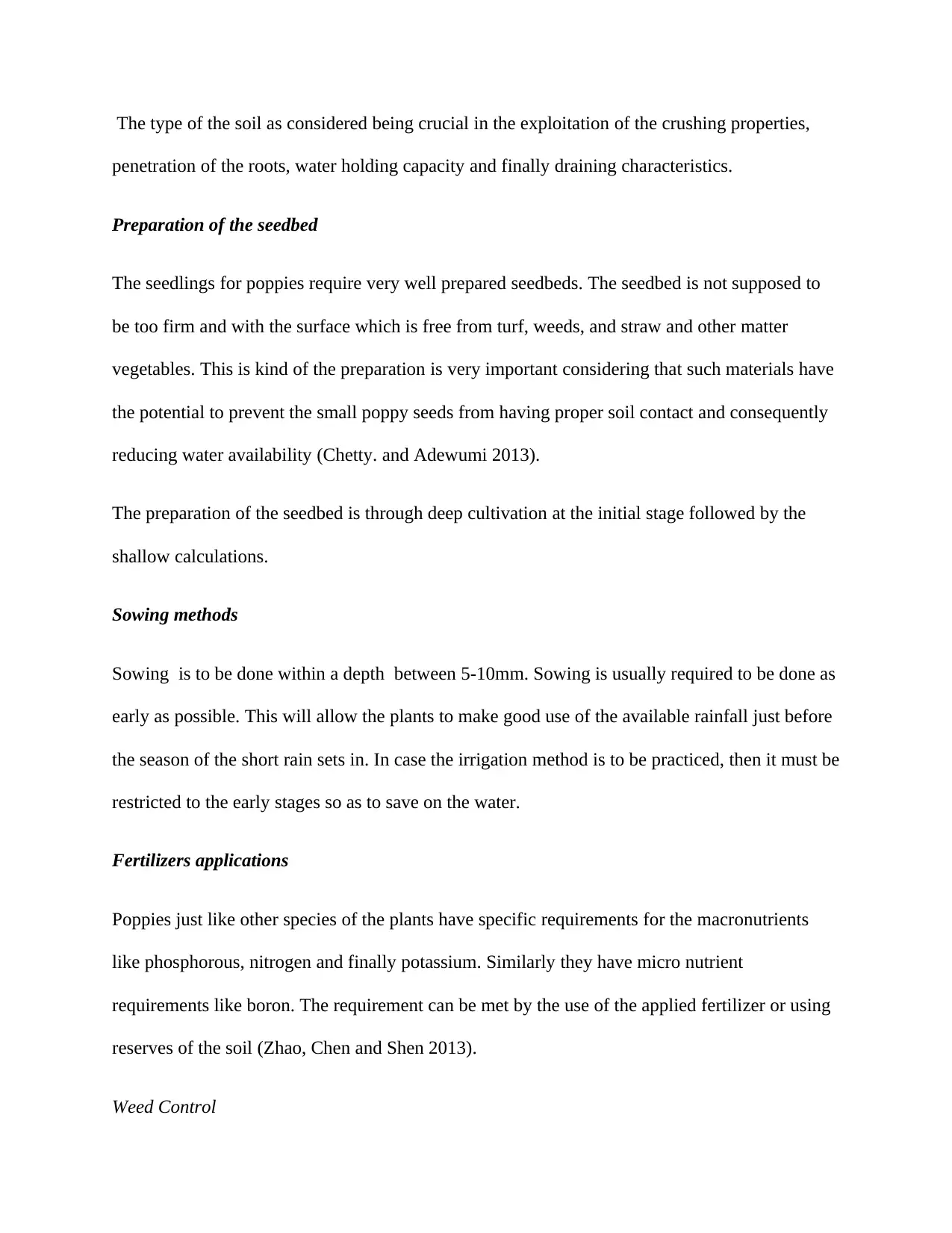
The type of the soil as considered being crucial in the exploitation of the crushing properties,
penetration of the roots, water holding capacity and finally draining characteristics.
Preparation of the seedbed
The seedlings for poppies require very well prepared seedbeds. The seedbed is not supposed to
be too firm and with the surface which is free from turf, weeds, and straw and other matter
vegetables. This is kind of the preparation is very important considering that such materials have
the potential to prevent the small poppy seeds from having proper soil contact and consequently
reducing water availability (Chetty. and Adewumi 2013).
The preparation of the seedbed is through deep cultivation at the initial stage followed by the
shallow calculations.
Sowing methods
Sowing is to be done within a depth between 5-10mm. Sowing is usually required to be done as
early as possible. This will allow the plants to make good use of the available rainfall just before
the season of the short rain sets in. In case the irrigation method is to be practiced, then it must be
restricted to the early stages so as to save on the water.
Fertilizers applications
Poppies just like other species of the plants have specific requirements for the macronutrients
like phosphorous, nitrogen and finally potassium. Similarly they have micro nutrient
requirements like boron. The requirement can be met by the use of the applied fertilizer or using
reserves of the soil (Zhao, Chen and Shen 2013).
Weed Control
penetration of the roots, water holding capacity and finally draining characteristics.
Preparation of the seedbed
The seedlings for poppies require very well prepared seedbeds. The seedbed is not supposed to
be too firm and with the surface which is free from turf, weeds, and straw and other matter
vegetables. This is kind of the preparation is very important considering that such materials have
the potential to prevent the small poppy seeds from having proper soil contact and consequently
reducing water availability (Chetty. and Adewumi 2013).
The preparation of the seedbed is through deep cultivation at the initial stage followed by the
shallow calculations.
Sowing methods
Sowing is to be done within a depth between 5-10mm. Sowing is usually required to be done as
early as possible. This will allow the plants to make good use of the available rainfall just before
the season of the short rain sets in. In case the irrigation method is to be practiced, then it must be
restricted to the early stages so as to save on the water.
Fertilizers applications
Poppies just like other species of the plants have specific requirements for the macronutrients
like phosphorous, nitrogen and finally potassium. Similarly they have micro nutrient
requirements like boron. The requirement can be met by the use of the applied fertilizer or using
reserves of the soil (Zhao, Chen and Shen 2013).
Weed Control
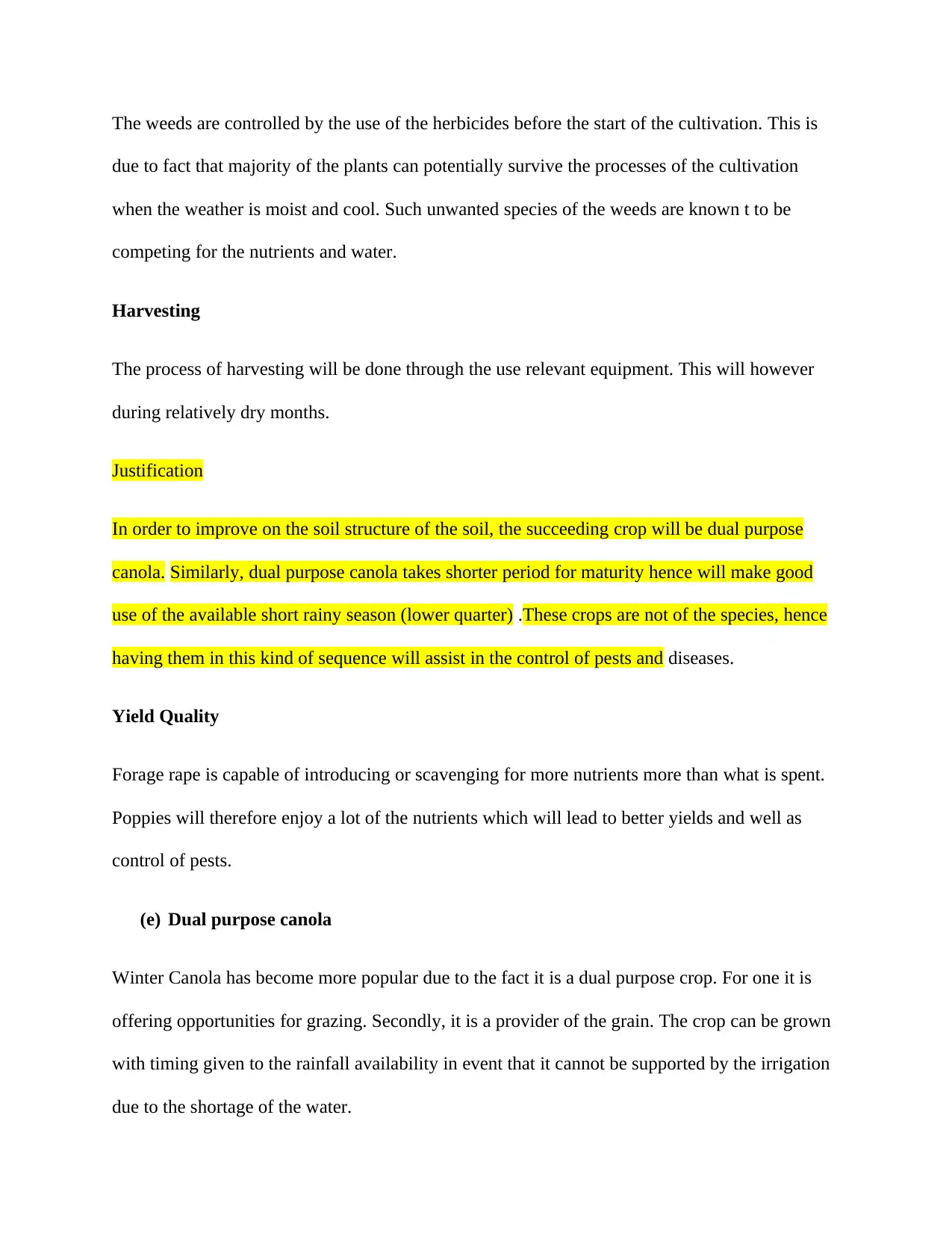
The weeds are controlled by the use of the herbicides before the start of the cultivation. This is
due to fact that majority of the plants can potentially survive the processes of the cultivation
when the weather is moist and cool. Such unwanted species of the weeds are known t to be
competing for the nutrients and water.
Harvesting
The process of harvesting will be done through the use relevant equipment. This will however
during relatively dry months.
Justification
In order to improve on the soil structure of the soil, the succeeding crop will be dual purpose
canola. Similarly, dual purpose canola takes shorter period for maturity hence will make good
use of the available short rainy season (lower quarter) .These crops are not of the species, hence
having them in this kind of sequence will assist in the control of pests and diseases.
Yield Quality
Forage rape is capable of introducing or scavenging for more nutrients more than what is spent.
Poppies will therefore enjoy a lot of the nutrients which will lead to better yields and well as
control of pests.
(e) Dual purpose canola
Winter Canola has become more popular due to the fact it is a dual purpose crop. For one it is
offering opportunities for grazing. Secondly, it is a provider of the grain. The crop can be grown
with timing given to the rainfall availability in event that it cannot be supported by the irrigation
due to the shortage of the water.
due to fact that majority of the plants can potentially survive the processes of the cultivation
when the weather is moist and cool. Such unwanted species of the weeds are known t to be
competing for the nutrients and water.
Harvesting
The process of harvesting will be done through the use relevant equipment. This will however
during relatively dry months.
Justification
In order to improve on the soil structure of the soil, the succeeding crop will be dual purpose
canola. Similarly, dual purpose canola takes shorter period for maturity hence will make good
use of the available short rainy season (lower quarter) .These crops are not of the species, hence
having them in this kind of sequence will assist in the control of pests and diseases.
Yield Quality
Forage rape is capable of introducing or scavenging for more nutrients more than what is spent.
Poppies will therefore enjoy a lot of the nutrients which will lead to better yields and well as
control of pests.
(e) Dual purpose canola
Winter Canola has become more popular due to the fact it is a dual purpose crop. For one it is
offering opportunities for grazing. Secondly, it is a provider of the grain. The crop can be grown
with timing given to the rainfall availability in event that it cannot be supported by the irrigation
due to the shortage of the water.
⊘ This is a preview!⊘
Do you want full access?
Subscribe today to unlock all pages.

Trusted by 1+ million students worldwide
1 out of 17
Your All-in-One AI-Powered Toolkit for Academic Success.
+13062052269
info@desklib.com
Available 24*7 on WhatsApp / Email
![[object Object]](/_next/static/media/star-bottom.7253800d.svg)
Unlock your academic potential
Copyright © 2020–2025 A2Z Services. All Rights Reserved. Developed and managed by ZUCOL.
